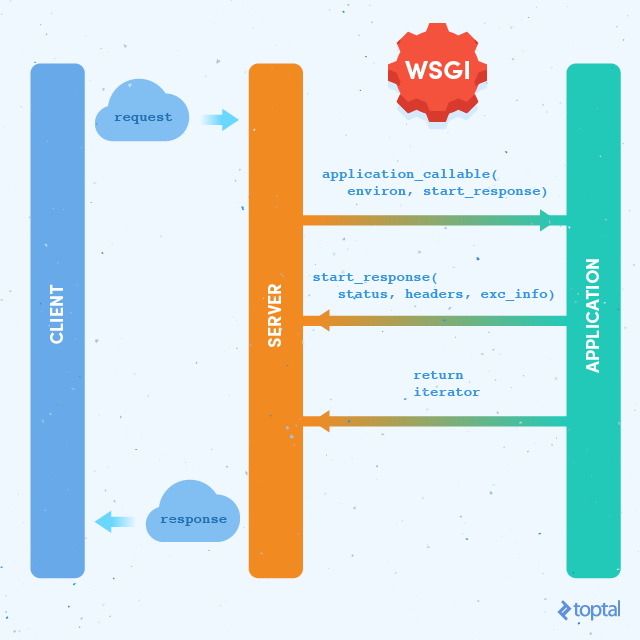Flask源码解析:Flask应用执行流程及原理
2018-08-16 22:30
537 查看
WSGI
WSGI:全称是Web Server Gateway Interface,WSGI不是服务器,python模块,框架,API或者任何软件,只是一种规范,描述服务器端如何与web应用程序通信的规范。Web应用程序的本质就是:
浏览器向服务器发送请求
服务器接受客户端请求,并解析
服务器端把HTML作为响应体发送给浏览器
浏览器拿取响应体渲染网页
在客户端和服务器端WSGI负责协议的转化,WSGI将web组件分为三部分:Web服务器、Web中间件、Web应用程序,当服务器接受到HTTP请求时,会按照WSGI协议解析成Request对象并调用WSGI Application,最后将响应返回给浏览器。
Werkzeug
Werkzeug是Python的WSGI规范的实用函数库。Flask使用的底层WSGI库就是Werkzeug。
WSGI 中有一个非常重要的概念:每个 Python web 应用都是一个可调用(callable)的对象。在 Flask 中,这个对象就是
app = Flask(__name__)创建出来的
app,就是图中绿色部分。
要运行Web应用,必须依赖于Web Server,比如我们常见的Apache、Nginx、Lighttpd以及我们Flask使用的Werkzug位于黄色部分。
WSGI规定了server和app之间如何进行通信,它规定了app(environ, start_response)接口,environ是环境设置的字典,包含了请求的所有信息,start_response是WSGI处理完毕后调用的函数。
源码位置:werkzeug.serving:WSGIRequestHandler中execute()。
HelloWorld启动流程
from flask import Flask
app = Flask(__name__)
@app.route("/")
def index():
return "Hello World"
if __name__ == "__main__":
app.run()应用启动的代码: app.run()
def run(self, host=None, port=None, debug=None,
load_dotenv=True, **options):
"""
... 部分代码省略
"""
_host = '127.0.0.1'
_port = 5000
server_name = self.config.get('SERVER_NAME')
sn_host, sn_port = None, None
if server_name:
sn_host, _, sn_port = server_name.partition(':')
host = host or sn_host or _host
port = int(port or sn_port or _port)
from werkzeug.serving import run_simple
try:
# 导入werkzeug.serving的run_simple(),传入接受到的参数
# 注意:第三个参数是self: 就是我们创建的Flask app
run_simple(host, port, self, **options)
finally:
self._got_first_request = Falserun_simple(host, port, self, **options)
监听指定的IP和端口,当接受到请求时,WSGI会解析,然后调用app去执行请求处理的逻辑。对应的逻辑在werkzeug.serving:WSGIRequestHandler的execute()中:
def execute(app): # 调用代码获取结果 application_iter = app(environ, start_response) try: for data in application_iter: write(data) if not headers_sent: write(b'') finally: if hasattr(application_iter, 'close'): application_iter.close() application_iter = None
可以看到application_iter = app(environ, start_response),调用app执行获取响应结果。
要调用app实例,那么会调用其__call__()方法。flask.app:Flask:
def __call__(self, environ, start_response): """The WSGI server calls the Flask application object as the WSGI application. This calls :meth:`wsgi_app` which can be wrapped to applying middleware.""" return self.wsgi_app(environ, start_response) def wsgi_app(self, environ, start_response): # 下篇博客讲 Flask上下文会解释,先忽略 ctx = self.request_context(environ) error = None try: try: ctx.push() # 正确的请求路径,会通过路由分发到响应的视图处理函数 response = self.full_dispatch_request() except Exception as e: error = e response = self.handle_exception(e) except: error = sys.exc_info()[1] raise return response(environ, start_response) finally: if self.should_ignore_error(error): error = None # 不管处理是否发生异常,都需要把栈中的请求 pop 出来 ctx.auto_pop(error)
上面代码业务逻辑就是通过路由配置,找到具体处理业务的视图函数。full_dispatch_request()相关代码:
def full_dispatch_request(self): """ 分派请求并在此之上执行请求处理 """ self.try_trigger_before_first_request_functions() try: request_started.send(self) rv = self.preprocess_request() if rv is None: rv = self.dispatch_request() except Exception as e: rv = self.handle_user_exception(e) return self.finalize_request(rv)
在这段中核心就是 self.dispatch_request() :
def dispatch_request(self): req = _request_ctx_stack.top.request if req.routing_exception is not None: self.raise_routing_exception(req) rule = req.url_rule if getattr(rule, 'provide_automatic_options', False) \ and req.method == 'OPTIONS': return self.make_default_options_response() # otherwise dispatch to the handler for that endpoint return self.view_functions[rule.endpoint](**req.view_args)
self.dispatch_request()返回的是处理函数的返回结果(比如Hello World 例子中返回的字符串),
finalize_request会把它转换成
Response对象。
在
dispatch_request之前我们看到
preprocess_request,之后看到
finalize_request,它们里面包括了请求处理之前和处理之后的很多 hooks:
before_first_request、
before_request、
after_request 、
teardown_request
相关文章推荐
- VirtualApp原理解析(3)--安装双开应用流程
- android源码解析(十六)-->应用进程Context创建流程
- Android图片加载框架最全解析(二),从源码的角度理解Glide的执行流程
- Struts2执行流程源码解析
- Spring基于注解形式的 AOP的原理流程及源码解析(一)
- Hadoop源码解析-作业执行流程-本地模式
- Android图片加载框架最全解析(二),从源码的角度理解Glide的执行流程
- Spring基于注解形式的 AOP的原理流程及源码解析(二)
- Hadoop源码解析-作业执行流程-集群模式
- Android图片加载框架最全解析(二),从源码的角度理解Glide的执行流程
- flask之源码解读RequestContext(请求上下文)执行流程
- ListView.setSelection(int)方法执行流程源码解析(API 21)
- SQL语句执行流程与顺序原理解析
- Nginx 源码分析-- 模块module 解析执行 nginx.conf 配置文件流程分析 一
- android源码解析之(十一)-->应用进程启动流程
- Mybatis源码详解之接口方法被执行流程源码解析
- struts2 之执行原理|源码解析|拦截器|权限案例(04)
- mybatis源码解析以及执行的流程
- Android图片加载框架最全解析(二),从源码的角度理解Glide的执行流程
- 【原创】angularjs1.3.0源码解析之执行流程
